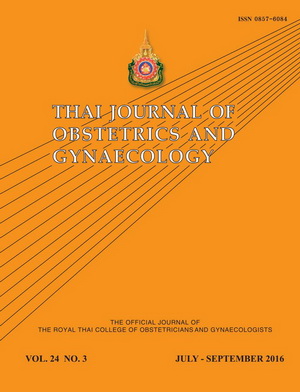Association between Maternal Body Mass Index and Sub-therapeutic Serum Magnesium Level in Severe Preeclampsia at Maharat Nakhon Ratchasima Hospital
Main Article Content
Abstract
Objectives: To evaluate the association between the maternal body mass index (BMI) and the subtherapeutic serum magnesium level in pregnant women with severe preeclampsia who received magnesium sulfate therapy at Maharat Nakhon Ratchasima Hospital.
Materials and Methods: A retrospective study from October 1, 2012 to March 31, 2015 was performed
to estimate the effect of maternal BMI on serum magnesium level. 565 (2.99%) pregnant women were diagnosed with severe preeclampsia or eclampsia and received magnesium sulfate therapy at Maharat Nakhon Ratchasima Hospital. Inclusion criteria was pregnant women who delivered at gestational age ≥ 24 weeks, women who did not receive expectant management, women who received magnesium sulfate following the regimen of loading dose 4 grams, followed by a maintenance dose of 1 gram/hour intravenously, and women who had monitored serum magnesium levels. Serum magnesium level was initially monitored at 3-4 hours after loading dose, and then monitored every 4 hours during magnesium sulfate infusion. The first serum magnesium level after loading dose was used in the study. Association between maternal BMI
and subtherapeutic serum magnesium level (magnesium level < 4.8 mg/dL) was evaluated.
Results: 18,923 women delivered during the study period. Intrapartum serum magnesium levels were monitored in 289 women, where 235 women (81.31%) had subtherapeutic mag-nesium level. Overweight and obese women were associated with a significantly higher risk of subtherapeutic serum magnesium level (P < 0.05). Renal insufficiency (creatinine > 1.1 gm/dL) and thrombocytopenia seem to have a significant correlation with a higher rate of therapeutic magnesium levels (P < 0.05).
Conclusion: Most cases of women with severe preeclampsia at Maharat Nakhon Ratchasima Hospital had subtherapeutic serum magnesium levels when magnesium sulfate was administered by loading dose 4 grams, followed by 1 gram per hour intravenously. Over-weightness and obesity were high risk factors contributing to subtherapeutic serum magne-sium levels.
Materials and Methods: A retrospective study from October 1, 2012 to March 31, 2015 was performed
to estimate the effect of maternal BMI on serum magnesium level. 565 (2.99%) pregnant women were diagnosed with severe preeclampsia or eclampsia and received magnesium sulfate therapy at Maharat Nakhon Ratchasima Hospital. Inclusion criteria was pregnant women who delivered at gestational age ≥ 24 weeks, women who did not receive expectant management, women who received magnesium sulfate following the regimen of loading dose 4 grams, followed by a maintenance dose of 1 gram/hour intravenously, and women who had monitored serum magnesium levels. Serum magnesium level was initially monitored at 3-4 hours after loading dose, and then monitored every 4 hours during magnesium sulfate infusion. The first serum magnesium level after loading dose was used in the study. Association between maternal BMI
and subtherapeutic serum magnesium level (magnesium level < 4.8 mg/dL) was evaluated.
Results: 18,923 women delivered during the study period. Intrapartum serum magnesium levels were monitored in 289 women, where 235 women (81.31%) had subtherapeutic mag-nesium level. Overweight and obese women were associated with a significantly higher risk of subtherapeutic serum magnesium level (P < 0.05). Renal insufficiency (creatinine > 1.1 gm/dL) and thrombocytopenia seem to have a significant correlation with a higher rate of therapeutic magnesium levels (P < 0.05).
Conclusion: Most cases of women with severe preeclampsia at Maharat Nakhon Ratchasima Hospital had subtherapeutic serum magnesium levels when magnesium sulfate was administered by loading dose 4 grams, followed by 1 gram per hour intravenously. Over-weightness and obesity were high risk factors contributing to subtherapeutic serum magne-sium levels.
Article Details
How to Cite
(1)
Boonyongchaisawat, R.; Kitiyodom, S. Association between Maternal Body Mass Index and Sub-therapeutic Serum Magnesium Level in Severe Preeclampsia at Maharat Nakhon Ratchasima Hospital. Thai J Obstet Gynaecol 2016, 24, 145-152.
Section
Original Article


